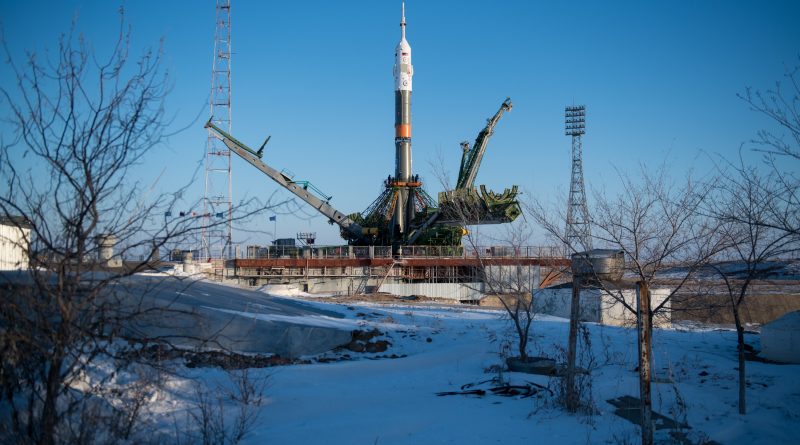Multinational Crew Trio on the Eve of Launch on Six-Month Space Station Mission
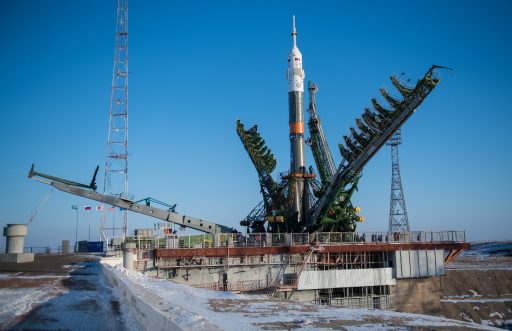
A third-time Soyuz commander, a physician-turned-astronaut, and a former naval test pilot are on the eve of liftoff atop a Russian Soyuz rocket taking them into orbit on Sunday for a five-and-a-half-month mission aboard the International Space Station.
Anton Shkaplerov, Norishige Kanai and Scott Tingle are set for liftoff from the Baikonur Cosmodrome at 7:21 UTC for a nine-minute ride into orbit followed by a two-day chase of the International Space Station leading up to docking on Tuesday.
The launch and docking of Soyuz MS-07 will complete a rapid-fire crew rotation that started on Thursday with the successful return to Earth by the Soyuz MS-05 spacecraft with crew members Sergey Ryazanskiy, Randy Bresnik and Paolo Nespoli who made their homecoming after a 139-day space flight and have since returned safely to their home bases. Originally, Soyuz MS-07 was targeting a same-day launch and docking on December 27, but its launch was brought forward on request of NASA to avoid having personnel at Baikonur or in transit over the holidays at the cost of losing the fast-track rendezvous and having to revert to the traditional 34-orbit flight profile taking Soyuz to its orbital destination two days after launch.
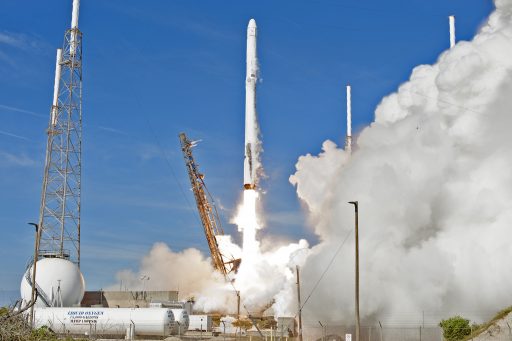
In addition to outbound and inbound Soyuz spacecraft, the International Space Station will welcome a SpaceX Dragon on Sunday, just three and a half hours after Soyuz MS-07 begins its chase of ISS. Loaded with 2,205 Kilograms of science gear and supplies, including two high-profile external payloads, the flight-proven Dragon lifted off from Florida on Friday and will make its second rendezvous with ISS on Sunday for a robotic capture to kick off a month-long stay.
Should anything go amiss with Dragon’s rendezvous, the spacecraft could safely perform another attempt 24 hours later before it would have to enter an orbital parking slot to give way to the incoming Soyuz since crewed spacecraft take priority.
Soyuz MS-07, the 136th flight of a Soyuz spacecraft in a five-decade program, will be commanded by Anton Shkaplerov – a veteran of two prior missions as Soyuz commander, spending a total of 365 days in orbit as part of ISS Expedition 29/30 in 2011/12 and Expedition 42/43 in 2014/15.
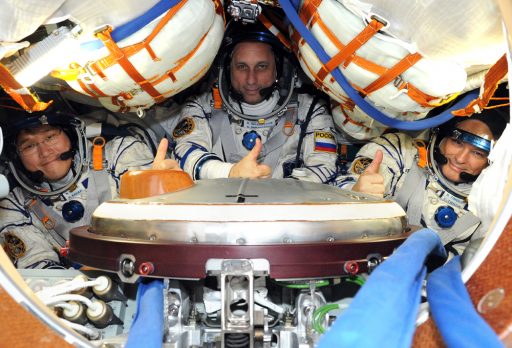
Shkaplerov, 45, comes from a military background, serving in the Russian Air Force until his selection as Cosmonaut in 2003. As part of his spaceflight career, Shkaplerov served as commander of Soyuz TMA-22, TMA-15M and now MS-07 – flying on all three ‘modern-day’ Soyuz variants introduced in the current millennium.
Bringing plenty of experience to the table, Anton Shkaplerov will be flanked to the left and right by two first-time space-fliers from the Japanese Aerospace Exploration Agency and NASA.
Riding in the ‘co-pilot’ seat on the left will be NASA’s Scott Tingle who, like the mission’s commander has a background in aviation, serving as a naval aviator in active combat and working as a test pilot from 1991 through 2009. Tingle, 52, accumulated 4,500 flights hours on over 50 aircraft when he was selected as an Astronaut Candidate in 2009. He was initially expected to fly on Soyuz MS-06, but crew re-shuffles due to Russia’s decision to cut its ISS crew complement to two placed him on the international crew trio of Soyuz MS-07.
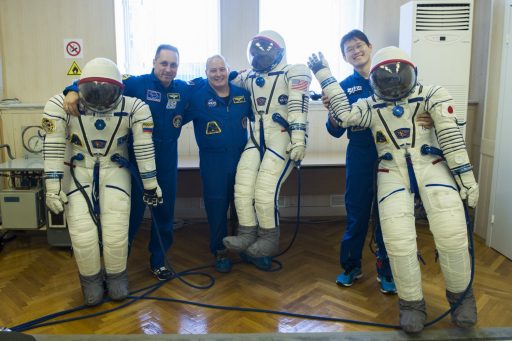
In a supporting role from the right seat will be JAXA’s Norishige Kanai who, at 40, is Japan’s youngest astronaut after being selected as one of three astronauts from 963 applicants in 2009.
In fact, Kanai was sure he was out the running when JAXA selected two Astronaut Candidates in the spring of 2009 and sent them off to train with NASA Astronaut Candidates in the U.S. His selection six months later came as a great surprise and, without reluctance, Kanai made the career change from being a physician in the Japanese military to training for a mission into space.
Soyuz MS-07 was originally booked for a mid-October liftoff, but was affected by the knock-on effect of the troubled Soyuz MS-04 mission that had to switch spacecraft in the late stage of its processing campaign due to a coolant leak on the original vehicle, causing an upset to the Soyuz launch schedule as production schedules had to be adjusted.
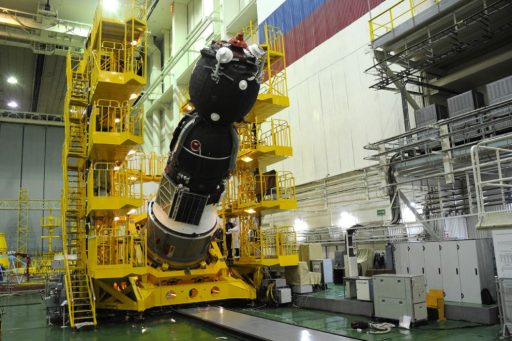
As a result, a number of missions slipped to the right this year and Soyuz MS-07 was looking at a fairly short mission of 122 days until this week when the 2018 schedule for Soyuz operations was updated and now shows the crew returning in June after a 168-day flight. Over the course of their tenure on ISS, the crew will have their hands full with a packed schedule, currently expecting to support over 300 scientific studies, oversee four visiting vehicle arrivals and support four or five spacewalks.
Due to the crew re-shuffles in late 2016, the Soyuz MS-07 crew members served on different backup assignments through 2017 and were joined in November when final training and simulation exams took place at the Gagarin Cosmonaut Training Center near Moscow. They traveled to the Baikonur Cosmodrome on December 4th for the typical two-week launch campaign that started off with a checkout of their Sokol Launch and Entry Suits and a dressed ingress rehearsal on their Soyuz as well as a final set of simulations aboard their spacecraft.
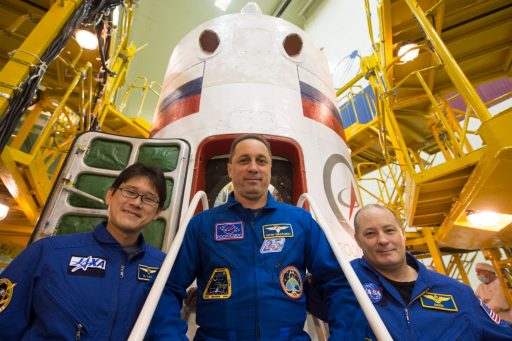
Soyuz was then shipped to the fueling facility to receive propellants and compressed gases before the seven-metric-ton spacecraft returned to the processing facility for attachment to its payload adapter and encapsulation in the payload fairing. On Wednesday, the crew made their last visit with the fully loaded Soyuz to get familiar with the situation on board and they also had a chance of visiting their 26-million-horsepower rocket at the MIK integration facility.
The 49.5-meter long Soyuz FG rocket took shape on Thursday when the encapsulated spacecraft was installed atop the rocket’s Block I upper stage that was then attached to the core stage which had its four boosters installed several weeks in advance. With Soyuz fully assembled, the way was clear for an early Friday rollout to the Site 1/5 launch pad that supported over 500 missions since the early days of space flight, including the historic launches of Sputnik and Yuri Gagarin.
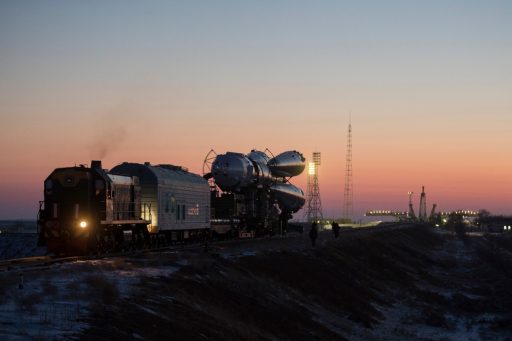
Weather for Sunday’s launch will be favorable with clear skies and low winds, but similar to the homecoming of Soyuz MS-05, the mercury will dip well below freezing with temperatures around -10°C expected at launch time. The Soyuz trio will climb into their spacecraft – flying under Shkaplerov’s call sign ‘Astrey’ – two and a half hours before launch, taking their seats atop 274 metric tons of explosive propellants needed to send them into orbit. Liftoff is timed for precisely 7:21:00 UTC, the moment Earth’s rotation carries Baikonur into the orbital plane of the Space Station.
Soyuz will swing to the north-east after liftoff, jettisoning its Launch Escape Tower and liquid-fueled boosters before hitting the two-minute mark. The protective launch shroud will drop away two and a half minutes after launch, giving the two rookie astronauts their first view of Earth’s curvature and thin atmosphere. Staging occurs four minutes and 45 seconds into the flight and Soyuz will fire its upper stage for another four minutes to reach a 200-Kilometer orbit.
Sailing off into orbit, Soyuz MS-07 will conduct a pair of engine burns on its third lap around the planet to begin raising its orbit toward the Space Station’s 400-Kilometer altitude. Monday will be very quiet for the crew with the focus on a small course correction toward the proper position for the initiation of the automated rendezvous on Tuesday morning. If all goes according to plan, Soyuz MS-07 will arrive in the Station’s vicinity for a slow flyaround and computer-controlled approach for docking at 8:43 UTC to mark the arrival of the second half of the ISS Expedition 54 crew.
Detailed Countdown & Launch Sequence
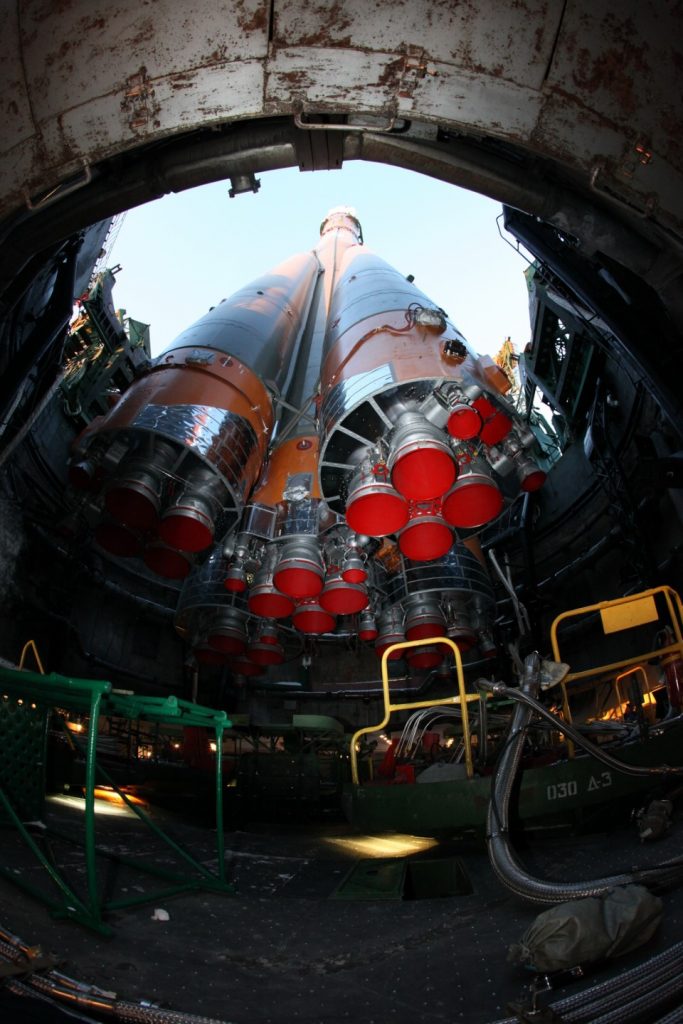
Out at Site 1/5, engineers will initiate the countdown sequence around eight hours prior to launch with the final set of fueling preparations. Once the two vehicles are activated, the Soyuz rocket and spacecraft complete a series of checkouts – communication checks, electrical testing and propulsion system testing is performed in the early stages of the countdown. Completing final hands-on work on the launch vehicle, engineers will install batteries on the booster and remove protective covers before standing by to receive a GO for propellant loading.
Five hours and 30 minutes ahead of launch, the Russian State Commission will meet to look at the overall status of the countdown and the results of launch vehicle and spacecraft testing to provide official approval for the beginning of tanking. By that time, the tanking cars will have already been rolled up to the pad and hooked up to Ground Support Equipment used to deliver propellants to the Soyuz launch vehicle.
Soyuz FG stands 49.5 meters tall and weighs 305,000 Kilograms when fully fueled. It can lift up to 7,200 Kilograms into Low Earth Orbit using a two-stage stack plus four liquid-fueled boosters clustered around the Core Stage – based on the original R7 design by Sergei Korolev.
Each of the boosters is 19.6m long consisting of a tapered and a cylindrical section with a maximum diameter of 2.68m and a launch mass of 43,410 Kilograms. Installed on each booster is a four-chamber RD-107A engine delivering 838.5 Kilonewtons of sea level thrust. The Core Stage is ignited with the boosters and continues to burn after the boosters separate, acting as combined first and second stage. It is 27.8m tall and 2.95 meters in diameter with a total launch mass of 99,500kg, featuring a 792-Kilonewton RD-108A engine and four verniers for vehicle control.
Sitting atop the Core Stage is the Block I third stage that is 6.74m long, 2.66m in diameter and weighs 25,300 Kilograms powered by a four-chamber RD-0110 engine with four vernier thrusters for vehicle control.
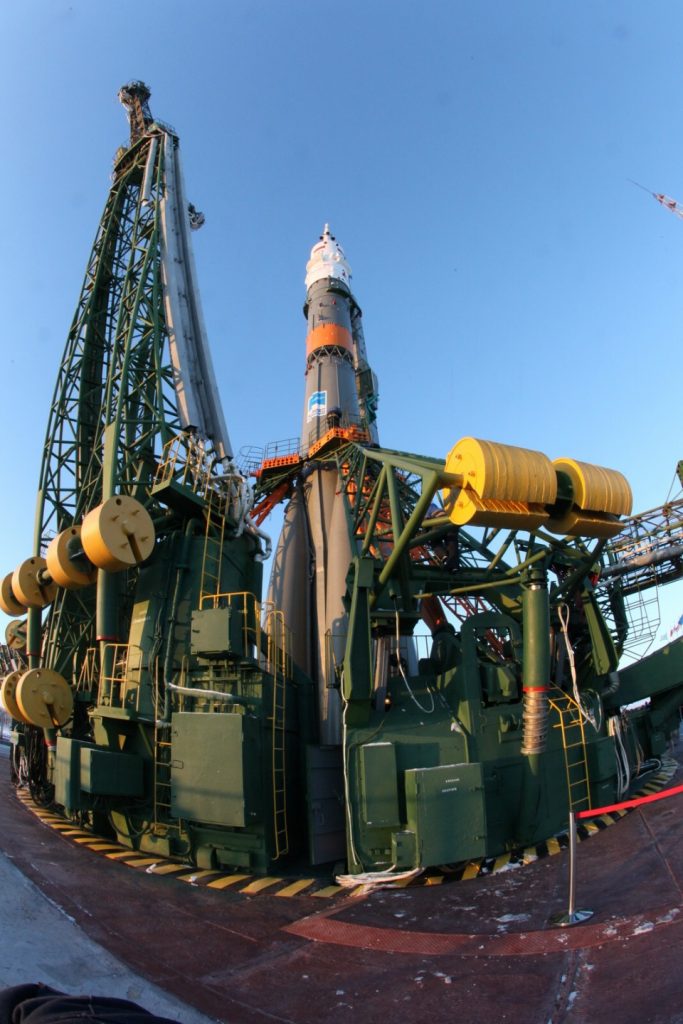
Over the course of a two-hour sequence, the boosters, the large Core Stage and the third stage are loaded with a total of 274,140 Kilograms of refined Kerosene and –183°C Liquid Oxygen. Additionally, the boosters and core stage will receive liquid Nitrogen to be heated during flight in order to pressurize the propellant tanks. At around L-3 hrs & 30 min, the boosters and core stage will be loaded with Hydrogen Peroxide to power the engine turbopumps during flight.
Around L-3 hours, the crew will depart Site 254, reporting to officials and boarding a bus for a half-hour ride to Site 1/5 that is hosting its 509th launch. Getting off their bus, the crew members will have a look at their fully fueled rocket, take a few photos with officials present at the pad and walk over to the Service Structure stairs to wave good-bye and enter the elevator taking them up to their Soyuz for crew ingress.
Climbing into the Soyuz through a hatch inside the Launch Shroud, the crew members will – one by one – enter the Orbital Module through its side hatch before climbing down through the Entry Module’s hatch to reach their Kazbek seat liners in the confined space of the small spacecraft.
Leak checks on the spacecraft pick up as soon as Soyuz has been sealed off and the crew will begin working through their pre-launch checklist that will take them about one hour to complete. 60 minutes ahead of launch, the Guidance System is activated and the flight computers receive their flight software 15 minutes later.
As hands-on work at the pad wraps up, teams will retract the two halves of the Soyuz Service Structure at L-40 minutes and put all ground systems in a safe configuration. Half an hour before T-0, the Launch Abort System will be activated and switched to automatic mode – ready to pull the Soyuz to safety in case of any serious problems.
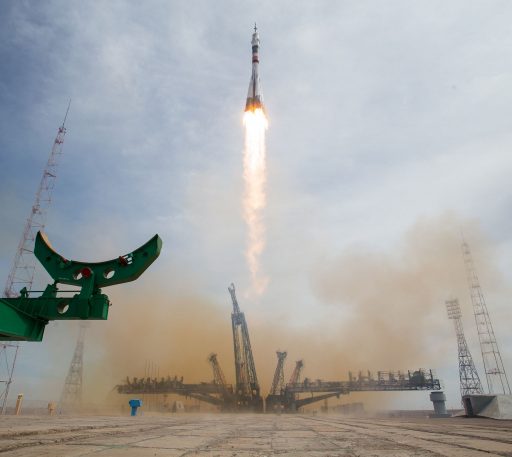
14 minutes ahead of launch, the Soyuz spacecraft is transferred to battery power and at L-10 minutes, the Soyuz FG inertial guidance system is configured for flight as gyros are uncaged and flight recorders are activated. Entering the Automated Countdown Sequence at T-6 minutes, the Soyuz launch vehicle will begin its final reconfigurations as part of a highly choreographed procedure.
Three minutes before launch, the five engines of the boosters and core stage are purged with nitrogen before propellant tank pressurization starts at T-2:35. Transfer to internal power occurs one minute before liftoff and Soyuz enables its Auto Sequencer that controls the final countdown events, coinciding with the retraction of the third stage umbilical mast from the rocket.
With the Auto Sequencer in control of the countdown, the Soyuz starts its ignition sequence at T-20 seconds as the turbopumps of the booster and core stage engines soar to flight speed and the engines reach an intermediate thrust level before being throttled up to full thrust for liftoff.
Blastoff is set for precisely 07:21:00 UTC, the optimized launch time based on the latest tracking data of the International Space Station. As clocks hit zero, Soyuz will begin rising from its launch pad with a total launch thrust of 422 metric tons, embarking on a nine-minute ascent mission following the usual flight profile.
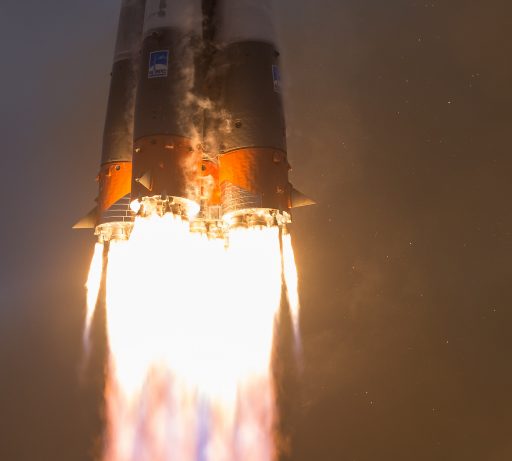
Soyuz FG passes through Maximum Dynamic Pressure and Mach 1 a little over 70 seconds into the flight, being powered by the RD-107A engines of the boosters and the RD-108A of the core. The Launch Abort System jettisons its Escape Tower at 114 seconds into the mission, marking the transition from low- to mid-altitude abort mode in a system that provides launch abort capability all the way to orbital insertion.
The four boosters and their RD-107A engines will burn for 1 minute and 58 seconds consuming a total of 39,600kg of propellants each to provide extra boost to the vehicle. After shutdown at an altitude of 49 Kilometers, the boosters are jettisoned from the core for a crash landing 348 Kilometers downrange.
With the boosters tumbling away from the Soyuz rocket, propulsion will only be provided by the Core Stage’s engine, delivering a thrust of 102,000 Kilogram-force when flying in the upper atmosphere. Two minutes and 37 seconds after launch, Soyuz will be over 80 Kilometers in altitude and jettison its protective Launch Shroud giving the crew a view outside through their small Entry Module windows, but the crew members will be focused on their displays, tracking the progress of their ascent into orbit.
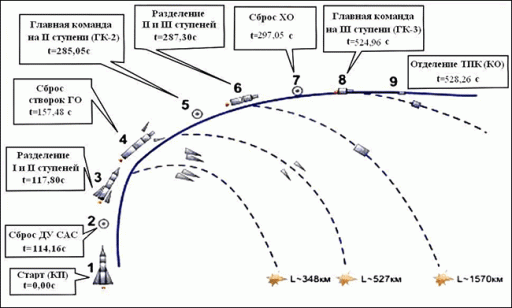
Four minutes and 45 seconds into the flight, the Core Stage will shut down its engine, marking the beginning of the hot staging sequence. Two seconds after cutoff, the third stage’s RD-0110 engine will be commanded to ignite and, at the same time, pyrotechnic bolts in the interstage will be fired to severe the connection between the empty Core Stage and the upper stage of the Soyuz that will continue powered ascent while the core heads toward re-entry and impact 1,570 Kilometers downrange from the launch site.
The third stage will fire its four-chamber engine and four gimbaling verniers for vehicle control until T+8 minutes and 45 seconds to achieve the planned insertion orbit. Just over two seconds after engine shutdown, the Soyuz spacecraft will separate from its rocket stage which itself will open up an oxygen valve to move away from the spacecraft.
Soyuz MS-07 is targeting the standard insertion orbit of 200 by 242 Kilometers inclined 51.67° from where the spacecraft will climb to meet up with ISS, currently orbiting at 403 by 406 Kilometers.
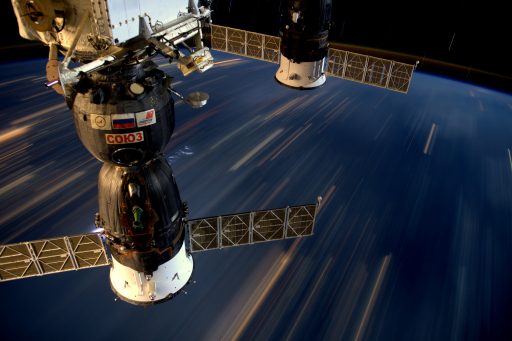
Immediately after separation from the carrier rocket, the Soyuz spacecraft will begin executing a series of time-tagged commands with deployment of the two power-generating solar arrays and KURS antennas planned eight seconds after the separation signal is received. After initial pressure integrity checks, the crew will be allowed to open their helmets and get comfortable for their first several orbits – dedicated to additional vehicle checks and a pair of critical engine burns.
A pair of engine burns is planned for the third orbit of the mission to lift the Soyuz from the initial orbit into an orbit over 300 Kilometers in altitude. Settling in aboard their Soyuz and going to sleep on their sixth lap around ISS, the trio can look forward to a quiet day on Monday dedicated to a manual attitude control test using a subset of the spacecraft’s thrusters as well as a small orbital correction on Orbit #17.
Soyuz is expected on the Station’s doorstep in the morning hours on Tuesday, making an automated approach to dock with the Rassvet module at 8:43:02 UTC to top up the Expedition 54 crew.

